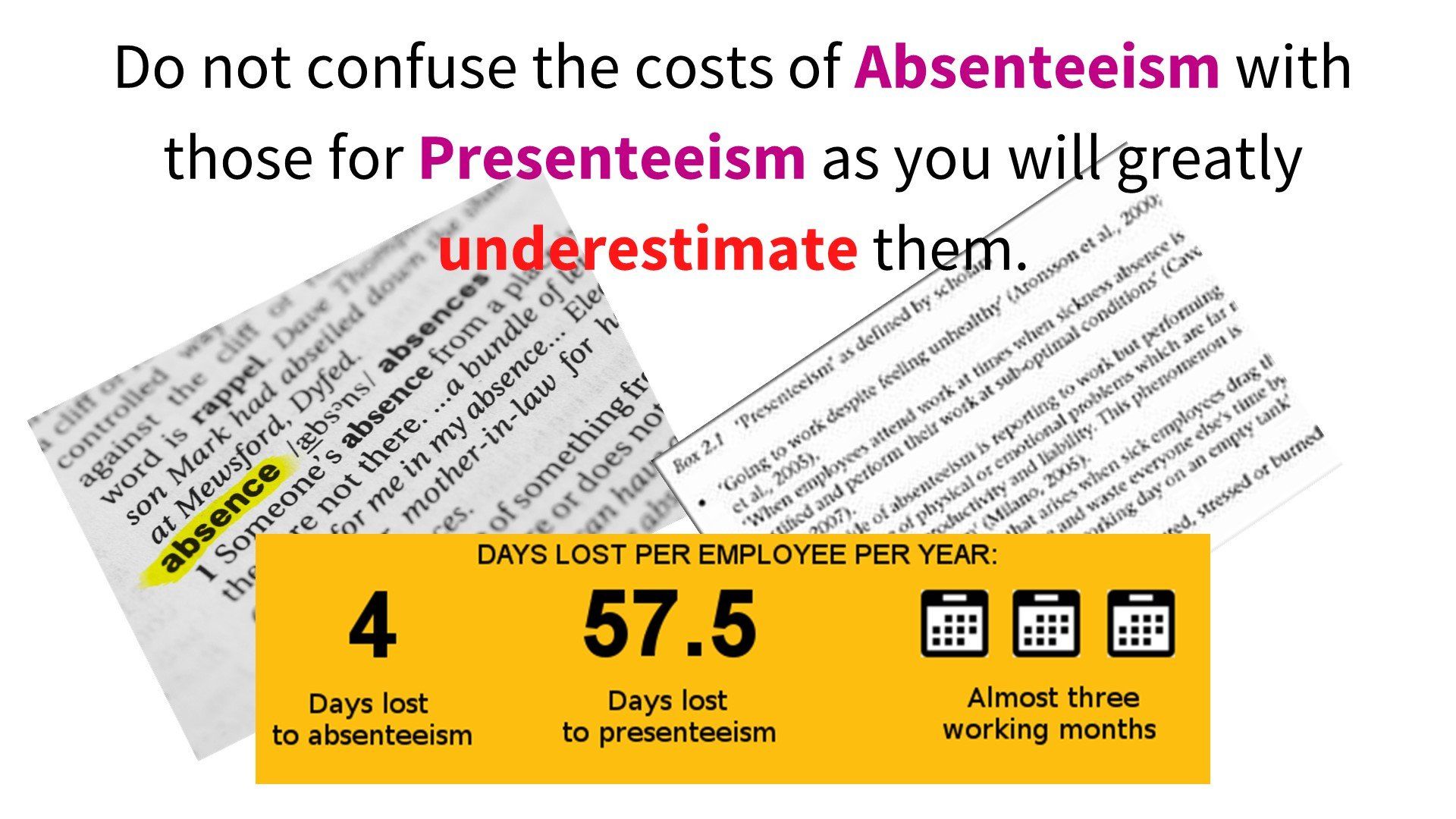
Presenteeism is real, it is not however the opposite of absenteeism. It is actually, being at work in body but through stress, anxiety, depression or other mental ill-health condition being unable to function effectively. As you can see from the picture above the costs are far greater with presenteeism because in the main the condition goes unnoticed. It is fairly common for my private clients to start off by telling that they are under a lot of pressure at work to improve or perform. Many have been on performance action plans, which for someone who is suffering from presenteeism is extremely unhelpful. I could quote so many examples, but I’ll just tell you about Jenny. Jenny had been a top performer for her employer for a number of years, winning many accolades and advancements. Then, all of a sudden, her line manager noticed that she wasn’t anywhere near as productive and was making uncharacteristic errors. This was apparently monitored for a short time before she was called in and told to up her game. She was put on an action plan that consisted of a new set of targets (greater than before) which she had to achieve before a set date, or the matter would be taken further. Subsequently, these targets weren’t achieved, and she was let go. Jenny came to see me privately and I discovered that she had a few months prior lost both her parents in an horrific car accident. No one at work knew about it as she could not speak about it without breaking down. She had taken annual leave over the period of the funerals so as again to hide this from her colleagues as she couldn’t talk about it. She had gone through the initial shock of the loss but was unable to come out the other side. The additional stress from work had pushed her further into depression. This whole work situation started with presenteeism that wasn’t picked up on by any of her colleagues until it was too late. I know what you’re thinking, she should have said something, and yeah your right, but when an employee doesn’t feel they can say anything for fear of being singled out, or treated as less of a person because of the stigma about mental health, and yes it still exists and this case proves it. We are getting there, but there is still a way to go. Her previous employer championed Wellness in the Workplace, so why did this situation still happen? In my opinion there are several reasons and here’s a couple. From the several hundred strong workforce only 3 were trained as Mental Health First Aider’s and none of them worked in the vicinity of Jenny’s work station; therefore, could not pick up on the obvious signs and symptoms that something was wrong. Also, when the performance dropped off to an extent her line manager (senior management level) called her in, there was no soft skills or compassion. She wasn’t even asked if there was a problem that he wasn’t aware of, she was told her performance had to improve and that he was all over her. I am so pleased to say that since Jenny started her sessions with me, she has come to terms with the awful loss of her parents, gone through the bereavement cycle and become much stronger. She is now a top performer for one of her previous employers’ main competitors, I think there is a little payback there for not looking after what was a very valued employee who clearly just need a little support. Mental Health in the workplace has been such a key topic over recent time. Companies have to have Mental Health and Stress in the Workplace policies and procedures in place under Health and Safety Legislation. Many businesses have followed governmental advice and trained members of staff as Mental Health First Aider’s (MHFA’s). One of the key roles for a MHFA is to spot the signs and symptoms of Stress, Anxiety and Depression amongst their colleagues, this then opens up the opportunity for early intervention. Early intervention is key to reducing the potential long-term harm caused to the body by the raised levels of adrenalin and cortisol. When your body is stressed you go into the fight or flight scenario which is the normal response, we either confront it head on or run away to safety. The trouble is fight or flight is a short-lived safety mechanism that needs to normalise. Now where most people are having problems is when the perceived danger/threat/stressor doesn’t diminish, and the stress levels stay high. The heightened state of readiness keeps the adrenalin and cortisol surging through our bodies and eventually they start to attack our muscles and vital organs. The side effects of these high levels cause all kinds of debilitating conditions. It’s like being prescribed medicine for a particular illness, the medicine does its job so you stop taking it, if you kept on taking it in time it will have a negative effect on your body. Presenteeism is a key indicator that something is wrong, therefore ensure all your employees are aware of the signs and symptoms and ensure that within the support you offer your employees is the provision for one to one counselling sessions. The most effective way of supporting your employees who need it. It is way more cost effective than presenteeism! If you would like an infographic on the signs and symptoms to circulate amongst your employees send me a quick email to paula@stressright.co.uk. Subject: infographic and I’ll send you the pdf. Ps. Jenny’s not her real name. Thanks for reading this your time is appreciated

I was delighted to be asked to write an article on generational differences in the workplace and how this has a major effect on employee stress. This is a new National Bookazine called 'Psychology Now', which is out now and available in WH Smiths and online at https://www.myfavouritemagazines.co.uk/knowledge/psychology-now Hope you enjoy reading it!







